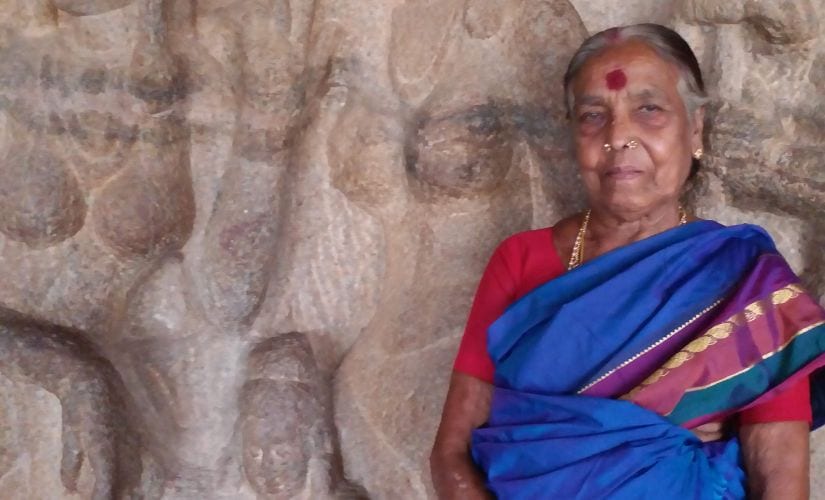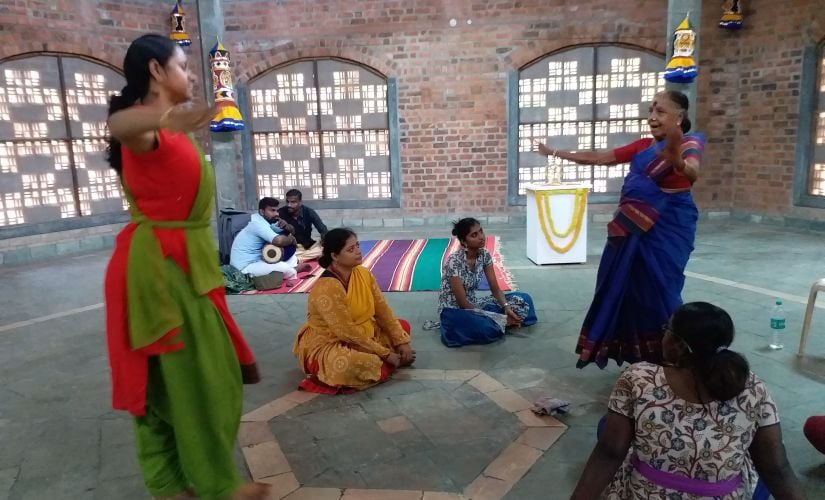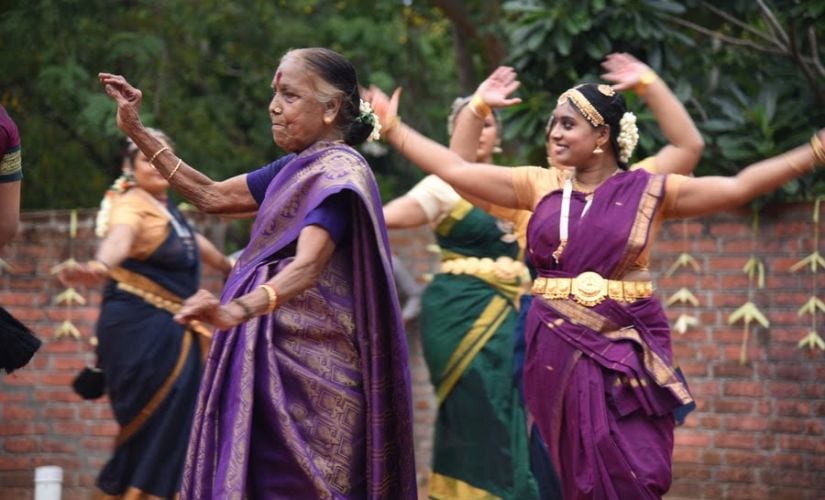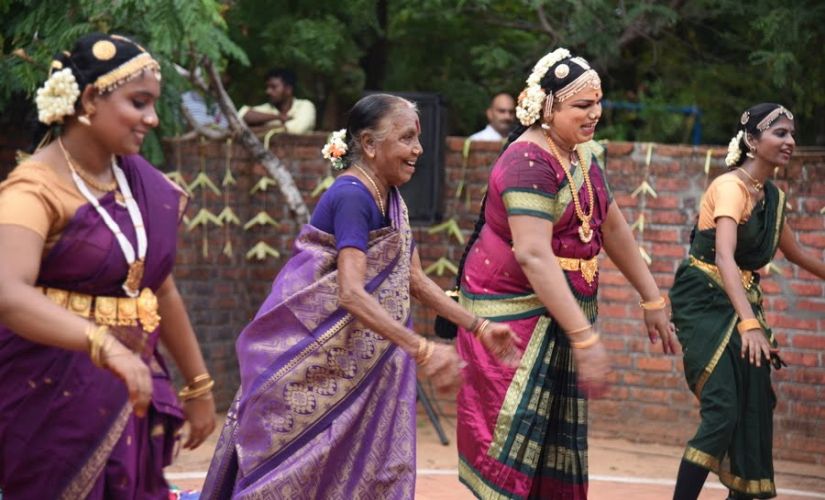Two Tamil women born in Pudukkottai won’t fade away quietly. One stands in the pantheon of Indian social reformers, though she passed away half a century ago. The other woman spent decades in obscurity, but has embarked on a surprising comeback. At age 80, she can still sing and dance simultaneously. Her repertoire even includes a jaunty salute, set to an old Irish marching band tune. Separated by time, these two women – Muthulakshmi Reddy and R Muthukkannammal — are bound by their focus on sadir, a precursor to the classical dance form now known as Bharatanatyam. They each carry stories of pride and prejudice. Muthulakshmi wanted to rescue these sadir dancers and their offspring; she was convinced that their pride could be restored through conventional marriages and useful occupations, such as teaching and nursing. She sought to place them far beyond the groping hands of male patrons. Yet Muthukkannammal never felt the need to be rescued; her pride lay in her artistry, and would never be snuffed out by the prejudice that engulfed her vocation. [caption id=“attachment_4949151” align=“alignnone” width=“825”]  R Muthukkannammal. Image courtesy: Margot Cohen[/caption] Two lives, two sets of convictions. They embody the complex, contentious history of sadir. In previous centuries, it was the exclusive province of the devadasis — who started out as young girls pledged to a particular temple and eventually fanned out to perform for indolent royals, prosperous landlords, and the masses thronging various festivals. The dance items ranged from the reverent to the humorous and the erotic. Views of the artists also varied. Admiration, disdain, and pity all mingled in this swirling milieu. Some dancers appeared powerful and enticing, while others seemed hopelessly exploited. Eventually, they were all tarred by the same sanctimonious brush. By the mid-20th-century, legal sanctions put the kibosh on sadir. Followers of Muthulakshmi rejoiced. “Dancing by a woman, in the precincts of any temple or other religious institution… or at any festival or ceremony held in respect of such a deity, idol or object of worship, is hereby declared unlawful,” stated the Madras Devadasis (Prevention of Dedication) Act of 1947. But in recent years, competing accounts of sadir and its practitioners have stirred up intense scholarly debate in India and abroad. Were the dancers treated unfairly? Was an art form stripped of its supple vitality? And can it be, in 21st century India, that sadir is still too hot to handle? Such questions form the backdrop of Muthukkannammal’s charismatic return to the limelight. In July 2018, a cultural center on the outskirts of Chennai made an unusual gesture. DakshinaChitra offered a welcoming stage to Muthukkannammal, who conducted a weeklong workshop with much younger dancers, capped by a joint performance. Earlier this year, DakshinaChitra also conferred a cash award on Muthukkannammal, mindful of her pinched circumstances. “Here is somebody who stood by her art against all odds, and kept that tradition going, irrespective of the fact that she didn’t have many people to teach it to,” observes Sreelatha Vinod, a prominent Bharatanatyam dancer and teacher in Chennai. In March, Sreelatha attended the award ceremony where Muthukkannammal spoke and performed for forty stamina-testing minutes. “How you emote to music: that is what she did so beautifully,” Sreelatha adds. [caption id=“attachment_4949171” align=“alignnone” width=“825”]  R Muthukkannammal with students. Image courtesy: Margot Cohen[/caption] With all the applause, it was tempting to forget the emotions that once surged in the opposite direction. Society’s ambivalence toward devadasis had scuttled support for sadir. As an activist, a medical doctor and legislator, born in July 1886, Muthulakshmi had lobbied hard for a law to abolish the practice of dedicating young female dancers to temples. Her determination overrode the objections of many devadasis themselves. Long before that law was passed, she set up Avvai Home in Madras in 1930, named after a Sangam poetess. Today, the institution still offers shelter and education to young girls, with a website that proudly highlights its history in offering “a moral life” to those “liberated from the ancient pernicious shackles” of the temple dedication. Just last month, Tamil Nadu governor Banwarilal Purohit attended the Avvai ceremony in honor of the home’s bespectacled founder. Did everyone want to be “liberated”? Not Muthukkannammal. Born in December 1937, in the Tamil year of Eesvara, she came from a long line of devadasi dancers, stretching over six generations. Some of their repertoires originated from the famed Brihadishvara temple in Tanjore. Her father was one of the most respected music masters in the locality. In their family’s case, dedication came with land grants and steady demand for performances in various temples, festivals and private salons. At age seven, Muthukannamal was called for her pottu kattuthal ceremony. She bowed her head for the sacred necklace, which she still wears today. Each morning, she entered the temple and traced delicate patterns on 32 plates of rice to present before the deity. In the evening, she returned to the sanctuary to sing lullabies. At home, she practiced her dance steps diligently. Her father gently taught her how to braid her hair and dress for the stage. But if she missed a note during vocal practice, he might also rap her with a stick. Then her life changed dramatically. The Madras Devadasis (Prevention of Dedication) Act was gradually enforced in the mid-1950s in Pudukkottai, several years after its formal passage in 1947. Meanwhile, Pudukkottai ruler Rajagopala Tondaiman fell from power in 1948, squelching opportunities to perform before the faded royals. No longer were the dancers affectionately called the “rubies of the palace.” To sustain the family, her father sold the land. And Muthukkannammal was left with very little. She did have her memory. She considered sadir dancing a privilege – not a source of shame. Quietly, she sang at home and moved along with the melodies. She developed a steady relationship with a man who valued her skills and never forced her to discard the ankle bells inherited from her ancestors. They had three children together. Unlike some of the other devadasis facing unemployment, she did not seek to reinvent herself in Tamil cinema. Neither did she leap to international acclaim like dancer Balasaraswati, whose ancestors were noted musicians and devadasis. Muthukkannammal barely had the chance to appear before devotees, except those who flocked to the annual chariot festival at the Pollachi Mariamman temple. She was deeply grateful to the thavil player who recommended her to temple authorities in the early 1980s as one of the few remaining devadasi artists who might be available to step into a ritual role. She was also permitted to perform periodically at a pavilion three kilometers from her home. There, she was given rice and new saris. Otherwise, the scorn surrounding the devadasi tradition discouraged Pudukkottai parents from sending their daughters to her for lessons. “After the system was banned, I stopped teaching. Children did not come,” Muthukkannammal recalls. “When I think about my early days, I wonder, why did things deteriorate like this?” [caption id=“attachment_4949351” align=“alignnone” width=“825”]  Muthukkannammal with other dancers. Image courtesy: DakshinaChitra[/caption] Elsewhere, in Chennai, parents from established families were persuaded to enroll their children for dance instruction at Kalakshetra, the prime laboratory for Bharatanatyam. Its founder, Rukmini Devi Arundale, adapted moves from sadir while promoting this dance as more pristine. Expression took different forms. For example, Bharatanatyam placed more emphasis on hand gestures known as mudhras. Love was still enacted, but overtly erotic movements were scrubbed. Gone, too, were the colonial touches that had crept into some of sadir’s more popular item numbers, such as the salute punctuating a breezy 18th-century Irish song called The Rakes of Mallow. Footwork reminiscent of European folk dances – along with other routines drawn from Indian folk dances – were also scrapped. All in all, Rukmini sought appreciation for Bharatanatyam as a refined form worthy of widespread acclaim and participation. Middle and upper-class parents need not fear that their daughters would be sullied by dancing in public. “She put it in a lovely platter, like a thali that is very beautifully showcased,” says Revathi Ramachandran, who became director of Kalakshetra in April 2018. Bharatanatyam went on to become one of India’s most well-known cultural exports, as well as a source of domestic pride. The government has supported numerous performances overseas. Many Indian families in the diaspora happily dispatch their daughters to learn it, and in some circles, such skills are a factor in eliciting marriage proposals. The story could have ended there. But the boundaries of what might be considered “respectable” have a way of shifting. And as young artists around the globe mine the past for inspiration – often excavating what has been marginalised, or ignored – the ankle bells of sadir beckoned. Fetched from her home five hours away in Viralimalai taluk, Muthukkannammal brought an assortment of accessories and instruments to DakshinaChitra. She played the very same cymbals that her father had used when she was a young girl: one iron, one brass, both wrapped in string. The students prostrated themselves before her, touching her feet. She was treated like any other treasured guru in the world of classical arts. With her erect posture and a ready grin, Muthukkannammal showed no trace of bitterness that a society who cast her off as a devadasi had waited so long before escorting her back to a position of respect. She surveyed the small group of students with delight. “They are ready to learn. I am surprised and happy,” she says. [caption id=“attachment_4949181” align=“alignnone” width=“825”]  Muthukkannammal (in the purple sari) performing with other dancers. Image courtesy: DakshinaChitra[/caption] Her weeklong workshop (16 to 21 July) was organised by the Coimbatore-based Udalveli Arts Foundation, led by theatre artist Dharanidharan. “Since I also come from this community, I feel I have a great responsibility to ensure this art form is taught to a new generation,” says Dharanidharan, explaining that his great-grandmother was a devadasi who danced at a Shiva temple in Elumathur, Erode. (The story goes that his ancestor was the second wife of a man who managed accounts at the temple, and she considered him her second husband, after Shiva.) Dharanidharan organised another sadir workshop in Coimbatore for dance instructors, and is planning another one especially for children. Dharanidharan was introduced to Mutthukkannammal by KT Gandhirajan, a heritage conservationist and explorer from Usilampatti with a special interest in ancient cave paintings. Such paintings have shed light on the crucial role that dance has played in the history of civilization. One evening, after a rehearsal, he invited Muthukkannammal to visit the rock temples at Mahabalipuram, a sight she had never seen. At DakshinaChitra, the students included 13-year Sarah Niveditha, a busy home-schooled teenager who takes lessons in Carnatic vocals, Bharatanatyam, and Veena. The day before Muthukkanammal’s workshop, Sarah accidentally stepped on a stingray after surfing in Kovalam. That didn’t stop her from joining rehearsals, despite a painful bandaged foot. Her mother hovered on the sidelines, keen for Sarah to learn something old, yet new. “The thing with Bharatanatyam is that the movements can be very stiff. Here, there is a really graceful flow,” says Sarah, during a break from practicing. “Most people think that Bharatanatyam is a more polished version, but I think I like this much more.” As for the adults, the workshop attracted mostly part-time dancers who had also pursued other careers in television, architecture, cultural administration and electronic media. One of the main challenges was learning how to sing and dance simultaneously. “If they could do it, maybe we can,” says 22-year-old Reshma Gunasekaran, trained in both Bharatanatyam and Kuchipudi. By the second day, Reshma seemed to sing more confidently, and easily executed gestures such as touching a dainty curled finger to a dimpled cheek. But it was hard work, too, as the students sat on the floor and struggled to transcribe the notes of the songs. Every so often, Muthukannammal walked gingerly outside the rehearsal studio, to spit out a mouthful of paan. One afternoon, Preeti Vasudevan dropped by to check that the sessions were fully documented on video. As the artistic director of Thresh, a contemporary dance company based in New York, she is working with the New York Public Library to increase accessibility of digital archives of Indian heritage. “I think workshops like these are very important,” says Preeti, who began studying Bharatanatyam at age five. “In terms of transmission of heritage, this could breathe new life into what we consider as “classical forms.” The fact that a living practitioner could demonstrate the songs made it easier to understand what has been lost, she explains. “The voice is connected to the breath. If those two are not connected, your inner environment is disconnected from the outer environment.” At Kalakshetra, dance students are also trained in vocal music, although they normally do not perform both at the same time. The panting and breathlessness that comes with vigorous dance can prevent a clear voice from emerging. However, Revathi believes that it’s not impossible for some performers to master both at once, as did Muthukkannammal in her youth. “We are looking at having her come to Kalakshetra to give a small lecture to the students,” says the new director. “The younger generation needs to know what sadir is.” [caption id=“attachment_4949201” align=“alignnone” width=“825”]  Dancers performing. Image credit: DakshinaChitra[/caption] In previous years, some Kalakshetra students have also made field trips to Thiruvidaimarudur to meet with descendants of devadasis and gain a fuller understanding of the history of dance. After all, one of Rukmini’s most important gurus was legendary devadasi Mylapore Gowri Amma. She was pledged to the Kapaleeshwarar temple in Madras — and was abruptly evicted due to the 1947 Act. In his compelling 2012 book Unfinished Gestures: Devadasis, Memory and Modernity in South India, scholar Davesh Soneji points out that the word devadasi has morphed into an umbrella term for many disparate communities. The current media focus on young girls who continue to be dedicated to temples (as in northern Karnataka) in violation of law, and often trafficked to brothels, has overshadowed the fact that in the 19th and early 20th centuries, many devadasis were commended for their artistry, their freedom, and their intellect. Some were guided in Sanskrit and had educational opportunities that surpassed many other women of their era. Today, some Indians express anger that sadir dancers were jettisoned by prejudice while abusive men remained unpunished. They do not uphold the crusading Muthulakshmi as a heroine. “The women could have been provided safe havens to sing, dance, be artistic and continue with their lives,” 31-year-old Chennai dancer Nrithya Pillai wrote in a recent essay. “In the name of sanitising society, the art and livelihood of these women were snatched away.” Nrithya, whose ancestors include women dedicated at the Vaitheeswaran Koil and Vazhuvoor temples five generations ago, says she was heartened by the recent award to Muthukkannammal. As for her performance, she saw “a lot of rawness and soul in it.” On 21 July, the same day that Muthukkannammal’s students performed at DakshinaChitra’s outdoor amphitheater, a very different event unfolded at Kalakshetra. There, scholar VR Devika gave a lecture defending Muthulakshmi’s legacy. Devika says she wants to push back at the recent tide of scholars who are “glorifying the devadasi” and disparaging past efforts to help them make a transition to other occupations. She has presented the same 90-minute lecture seven times around the country, in venues ranging from Vadodara to New Delhi and Chennai. Devika notes that Muthulakshmi had first-hand knowledge of the devadasi system since her mother was a descendant of this community and she was concerned by the fate of her maternal cousins. Given that Muthulakshmi’s father was a college principal, she was able to rise in society. “She felt guilty of having been the privileged one, among the community,” explains the 64-year-old founder of the Aseema Trust in Chennai. Devika insists that Muthulakshmi was not opposed to the art of sadir, but abhorred the practice of compulsory dedication to temples. She wanted abusive men to be punished, too, but most politicians and the court system did not support that view. “The Act was not looking at the art, it was looking at the dedication of young girls. If the art suffered, it was collateral damage,” Devika concludes. “No reform in the world would be 100 percent beneficial to everyone. What I’m saying is that it was mostly successful.” In her 20s, while still a schoolteacher, Devika began her own training in Bharatanatyam. She would never go on to perform. For all of her spirited defense of the anti-dedication campaign, she reserves some warmth for people like Muthukkannammal, whose lives were arguably blighted by the “collateral damage” of Muthulakshmi’s lobbying efforts. Did she catch the DakshinaChitra award ceremony? “Unfortunately, I didn’t go. I regret it. I curse myself for not going,” she says vehemently. “It would have been important for me to show my support for her.” Back at the amphitheater, Muthukkannammal appeared in a purple silk sari and took her place among the younger performers. At times, she pursed her lips in concentration. But mostly, she seemed buoyed by the collective energy. It was much better than dancing alone, at home. Margot Cohen writes about culture in Asia. She is a former correspondent for The Far Eastern Economic Review.
In recent years, competing accounts of sadir and its practitioners have stirred up intense scholarly debate in India and abroad.
Advertisement
End of Article


)
)
)
)
)
)
)
)
)



